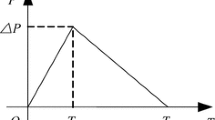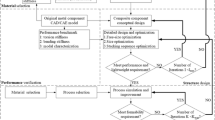Abstract
The paper presents an integrated design approach of composite bay door with pre-deformation and variable thickness optimization. Firstly, design and optimization of functional composite curved surface are discussed. To avoid adopting locking mechanism, a design of pre-deformation is used in aircraft bay door to keep the door closed. In this paper, the curve of composite bay door is considered as part of design variables. By means of the internal forces caused by the deformation of curve, the aircraft bay door could be able to fix in target position firmly and stably. The pre-deformation of bay door is controlled by particular parametric Bezier curve, which provides abundant changing range to meet the needs. Secondly, the variable thickness optimization of composite laminates is introduced. To take full advantage of designability of composites, variable thickness design is actualized through partitioning in bay door, not only considering the weight reduction of the structure, but also ensuring the enough strength and stiffness in the critical load positions where the strength and stiffness requirements are harsh. Furthermore, the integrated optimization is carried out based on the method of concurrent subspace optimization (CSSO).










Similar content being viewed by others
Abbreviations
- Φ :
-
Stacking sequence of all partitions
- Φ tc :
-
Design domain satisfying manufacturing consideration
- P k :
-
k-order control points of Bezier curve
- α :
-
Reduction coefficient of overall pre-deformation structure’s thickness
- g j :
-
Overall structure failure function corresponding to constraints of strength and stiffness
- S :
-
Compliance coefficients
- ε :
-
Vectors of strain in laminated composite
- σ :
-
Vectors of stress in laminated composite
- σ i, τ ij :
-
Stress components
- ε i, γ ij :
-
Strain components
- Q ij :
-
The Q matrix coefficients in kth ply
- F i, F ij :
-
Strength coefficients related to strength parameters
- F. I.:
-
Failure index of the Tsai-Wu failure criterion
- g 1 :
-
Failure function corresponding to constraints of strength
- S z :
-
Shearing strength
- g 2 :
-
Failure function for the sake of illustration
- u 0, v 0, w 0 :
-
Displacements of the point in mid-plane
- θ x, θ y :
-
Angles of normal line of the mid-plane relative to x- and y-axes
- N :
-
Matrixes of in-plane force, moment, and shearing force in mid-plane
- A :
-
Stiffness matrixes of tensile
- B :
-
Stiffness matrixes of coupling
- D :
-
Stiffness matrixes of bending
- C s :
-
Stiffness matrixes of shearing
- ε 0 :
-
The vector of strains
- κ :
-
The vector of bending curvature of mid-plane
- w :
-
Deflection of the bay door
- D ref :
-
The displacement constraint that the structure needs to satisfy
- D max :
-
The maximum displacement caused by external forces
- g 3 :
-
Failure function corresponding to constraints of stiffness
- W :
-
Structural weight
- \( {t}_0^i,{t}_{90}^i,{t}_{\pm 45}^i \) :
-
The thicknesses of super layers
- g j :
-
The overall structure failure constraints function of strength and stiffness
- q(t i):
-
Interpolation corresponding to point ti
- m :
-
The order of the Bezier curve
- \( f\left(z,x,\overset{\sim }{y}\right) \) :
-
Objective function of system-level
- \( g\left(z,x,\overset{\sim }{y}\right) \) :
-
Constrain function in system-level
- z :
-
The global variables
- x :
-
The local variables
- \( f\left({z}_i,{z}_0,\cdots, \overset{\sim }{y_j}\right) \) :
-
Objective function of disciplinary-level
- \( g\left({z}_i,{z}_0,\cdots, \overset{\sim }{y_j}\right) \) :
-
Constrain function in disciplinary-level
- z i :
-
The global variables in each disciplinary
- x i :
-
The local variables in each disciplinary
- z 0 :
-
The global variables containing constants
- x 0 :
-
The local variables containing constants
References
An H, Chen S, Huang H (2015) Simultaneous optimization of stacking sequences and sizing with two-level approximations and a genetic algorithm. Compos Struct 123:180–189
An H, Chen S, Huang H (2018) Multi-objective optimization of a composite stiffened panel for hybrid design of stiffener layout and laminate stacking sequence. Struct Multidiscip Optim 57(4):1411–1426. https://doi.org/10.1007/s00158-018-1918-2
Cenko A, Deslandes R, Dillenius M, Stanek M (2008) Unsteady weapon bay aerodynamics - urban legend or flight clearance nightmare. 46th AIAA aerospace sciences meeting and exhibit. Reno, Nevada
Chen X, Wang X, Qiu Z, Wang L, Li X, Shi Q (2018) A novel reliability-based two-level optimization method for composite laminated structures. Compos Struct 192:336–346
de Quadros HB, Hernandes JA (2018) A Lagrange parametrization for the design of variable stiffness laminates. Struct Multidiscip Optim 58(1):129–137. https://doi.org/10.1007/s00158-017-1882-2
Ferreira RTL, Rodrigues HC, Guedes JM, Hernandes JA (2014) Hierarchical optimization of laminated fiber reinforced composites. Compos Struct 107(1):246–259
Han J, Hoa SV (1993) A three-dimensional multilayer composite finite element for stress analysis of composite laminates. Int J Numer Methods Eng 36(22):3903–3914
Huang XC, Zhou XP (2017) Reliability analysis of a large-scale landslide using SOED-based RSM. Environ Earth Sci 76(23):794
Huang H, Huang SS, Pilakoutas K (2018) Modeling for assessment of long-term behavior of prestressed concrete box-girder bridges. J Bridg Eng 23(3): 04018002
Hyer MW (2009) Stress analysis of fiber-reinforced composite materials. DEStech Publications, Inc., Lancaster
Kant T, Swaminathan K (2000) Estimation of transverse/interlaminar stresses in laminated composites – a selective review and survey of current developments. Compos Struct 49(1):65–75
Kussmaul R, Zogg M, Ermanni P (2018) An optimality criteria-based algorithm for efficient design optimization of laminated composites using concurrent resizing and scaling. Struct Multidiscip Optim 58(2):735–750. https://doi.org/10.1007/s00158-018-1927-1
Liu X, Mahadevan S (2000) Ultimate strength failure probability estimation of composite structures. J Reinf Plast Compos 19(5):403–426
Liu DF, Tang YJ, Cong WL (2012) A review of mechanical drilling for composite laminates. Compos Struct 94(4):1265–1279
Lund E, Stegmann J (2005) Structural optimization of composite shell structures using a discrete constitutive parameterization. Wind Energy 8(1):109–124
Nayyar P, Barakos G, Badcock K (2005) Analysis and control of weapon bay flows. Paper presented at the RTO AVT-123, Conference on flow-induced unsteady loads and the impact on military applications
Nik MA, Fayazbakhsh K, Pasini D, Lessard L (2014) A comparative study of metamodeling methods for the design optimization of variable stiffness composites. Compos Struct 107(1):494–501
Orifici AC, Thomson RS, Degenhardt R, Bisagni C, Bayandor J (2009) A finite element Methodology for analysing degradation and collapse in postbuckling composite aerospace structures. J Compos Mater 43(2009–12):3239–3263
Peeters D (2017) Design optimisation of practical variable stiffness and thickness laminates. https://doi.org/10.4233/uuid:a07ea6a4-be73-42a6-89b5-e92d99bb6256
Riche RL, Haftka RT (2012) Optimization of laminate stacking sequence for buckling load maximization by genetic algorithm. AIAA J 31(5):951–956
Setoodeh S, Abdallah M, Gurdal Z, Tatting B (2006) Design of variable-stiffness composite laminates for maximum in-plane stiffness using lamination parameters. Aiaa/asme/asce/ahs/asc structures. Structural Dynamics and Materials Conference
Sloan J (2012) Integrated, optimized aircraft door. High Perform Compos 61–68
Stanley P, Chan WK (1988) The application of thermoelastic stress analysis techniques to composite materials. J Strain Anal Eng Des 23(3):137–143
Stegmann J, Lund E (2005) Discrete material optimization of general composite shell structures. Int J Numer Methods Eng 62(14):2009–2027
Tahani M, Nosier A (2003a) Free edge stress analysis of general cross-ply composite laminates under extension and thermal loading. Compos Struct 60(1):91–103
Tahani M, Nosier A (2003b) Three-dimensional interlaminar stress analysis at free edges of general cross-ply composite laminates. Mater Des 24(2):121–130
Tahani M, Nosier A (2004) Accurate determination of interlaminar stresses in general cross-ply laminates. Mech Adv Mater Struct 11(1):67–92
Tserpes KI, Koumpias AS (2015) A numerical methodology for optimizing the geometry of composite structural parts with regard to strength. Compos Part B Eng 68:176–184
Vosoughi AR, Darabi A, Forkhorji HD (2017) Optimum stacking sequences of thick laminated composite plates for maximizing buckling load using FE-GAs-PSO. Compos Struct 159:361–367
Ye H, Zhang Y, Yang Q, Xiao Y, Grandhi RV, Fischer CC (2017) Optimal design of a three tape-spring hinge deployable space structure using an experimentally validated physics-based model. Struct Multidiscip Optim 56(5):973–989
Zehnder N, Ermanni P (2006) A methodology for the global optimization of laminated composite structures. Compos Struct 72(3):311–320
Funding
The work is supported by the National Key Research and Development Program (No. 2016YFB0200700), the National Nature Science Foundation of the P.R. China (No. 11872089, No. 11572024, No. 11432002), and the Defense Industrial Technology Development Program (No. JCKY2017601B001, No. JCKY2016601B001) for the financial supports.
Author information
Authors and Affiliations
Corresponding author
Additional information
Responsible Editor: Somanath Nagendra
Publisher’s Note
Springer Nature remains neutral with regard to jurisdictional claims in published maps and institutional affiliations.
Rights and permissions
About this article
Cite this article
Wang, X., Cai, Y. & Geng, X. Integrated optimization of composite bay door with pre-deformation and variable thickness design. Struct Multidisc Optim 59, 1673–1684 (2019). https://doi.org/10.1007/s00158-018-2155-4
Received:
Revised:
Accepted:
Published:
Issue Date:
DOI: https://doi.org/10.1007/s00158-018-2155-4




